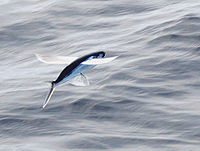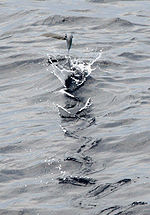- Atlantic flyingfish
-
Atlantic flyingfish 
In flight Scientific classification Kingdom: Animalia Phylum: Chordata Class: Actinopterygii Order: Beloniformes Family: Exocoetidae Genus: Cheilopogon Species: C. melanurus Binomial name Cheilopogon melanurus
Valenciennes, 1847Synonyms The Atlantic flyingfish (Cheilopogon melanurus) is a flying fish in the family Exocoetidae. It was first described by the French zoologist, Achille Valenciennes in a 22-volume work entitled Histoire naturelle des poissons (Natural History of Fish), which was a collaboration with fellow zoologist, Georges Cuvier.
Contents
Description
Like many other flyingfishes, the Atlantic flyingfish has a cylindrical body, and large tail and pectoral fins that it uses for flight. To fly, the Atlantic flyingfish jumps out of the water, uses its pectoral fins to catch air currents and provide lift, and beats its tail back and forth to provide thrust.[1] The longest recorded individual was 32 cm long,[2] but most adults are roughly 25 cm long.[1] Atlantic flyingfish are generally green to blue dorsally, and white or silver ventrally.[1] After reaching a speed of 30 km/h,[3]:124 Atlantic flyingfish jump out of the water and can glide 3 to 12 m.[3]:32 This is presumably done to avoid ocean-going predators.[4]
Distribution and habitat
As its name suggests, the Atlantic flyingfish is only found from the pelagic zone to the neritic zone[5] in the ocean it is named for. In the western Atlantic, they are known to live in Gulf Stream waters from Massachusetts south to Brazil.[5] They are found in the Caribbean Sea and around the Antilles,[6] while in the north, they are found off the coast of Canada.[7] Off Africa, Atlantic flyingfish are known from Senegal to Liberia,[8] and have been reported from São Tomé and Príncipe.[9] They are found in surface waters near shore,[2] where Atlantic flyingfish are preyed upon by several species of larger fishes and seabirds, such as the Wahoo[10] and Sooty tern.[11] Young Atlantic flyingfish up to 15 centimetres (5.9 in) in length have transparent pectorals and often swim in harbors or bays.[3]:124
References
- ^ a b c "Atlantic Flying Fish". animalexploration.tripod.com. http://animalexploration.tripod.com/flyingfish.html. Retrieved 2009-06-21.
- ^ a b Cervigón, F., R. Cipriani, W. Fischer, L. Garibaldi, M. Hendrickx, A.J. Lemus, R. Márquez, J.M. Poutiers, G. Robaina and B. Rodriguez 1992 Fichas FAO de identificación de especies para los fines de la pesca. Guía de campo de las especies comerciales marinas y de aquas salobres de la costa septentrional de Sur América. FAO, Rome. 513 p. Preparado con el financiamento de la Comisión de Comunidades Europeas y de NORAD.
- ^ a b c Stokes, F. Joseph (1994) [1984]. Divers and Snorklers Guide to the Fishes and Sea Life. Singapore: The Academy of Natural Sciences of Philadelphia. ISBN 0910006466. http://books.google.com/books?hl=en&lr=&id=-KWf5_WHSJQC&oi=fnd. Retrieved 2009-06-22.
- ^ "Flyingfish". http://animals.nationalgeographic.com/animals/printable/flying-fish.html. Retrieved 2009-06-30.
- ^ a b Froese, Rainer, and Daniel Pauly, eds. (2009). "Cheilopogon melanurus" in FishBase. 05 2009 version.
- ^ Smith, C.L. 1997 National Audubon Society field guide to tropical marine fishes of the Caribbean, the Gulf of Mexico, Florida, the Bahamas, and Bermuda. Alfred A. Knopf, Inc., New York. 720 p.
- ^ Scott, W.B. and M.G. Scott 1988 Atlantic fishes of Canada. Can. Bull. Fish. Aquat. Sci. 219: 731 p
- ^ Parin, N.V. and R.H. Gibbs, Jr. 1990 Exocoetidae. p. 583-591. In J.C. Quero, J.C. Hureau, C. Karrer, A. Post and L. Saldanha (eds.) Check-list of the fishes of the eastern tropical Atlantic (CLOFETA). JNICT, Lisbon; SEI, Paris; and UNESCO, Paris. Vol. 2.
- ^ Afonso, P., F.M. Porteiro, R.S. Santos, J.P. Barreiros, J. Worms and P. Wirtz 1999 Coastal marine fishes of São Tomé Island (Gulf of Guinea). Arquipélago 17(A):65-92.
- ^ Manooch, C.S. III and W.T. Hogarth 1983 Stomach contents and giant trematodes from wahoo, Acanthocybium solanderi, collected along the south Atlantic and coasts of the United States. Bull. Mar. Sci. 33(2):227-238.
- ^ Hensley, V.I. and D. A. Hensley 1995 Fishes eaten by sooty terns and brown noddies in the Dry Tortugas, Florida. Bull. Mar. Sci. 56(3):813-821.
External links
Categories:- Exocoetidae
Wikimedia Foundation. 2010.

